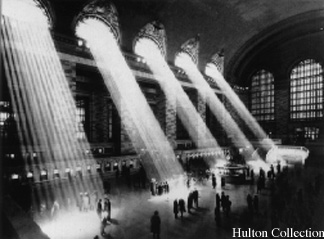

The Straight and Narrow
What do you first notice about the image above? I see beautiful beams of sunlight streaming into Grand Central Station from windows high overhead. Then I notice that these sunbeams are streaming in with absolutely straight paths. Why is the light traveling in straight paths? Shouldn't it be bent due to the "refraction" of the windows?The second question is an easy one to answer. Yes, the light is bent at the window, but only at the interface (boundary) between the window and the surrounding air. We deal with this topic of light bending (refraction) in a later module. Here, we just need to realize that the light path is absolutely straight when the light is not encountering any interface. So whether its traveling through air, water, glass, diamond, or any substance (or none at all), light travels in a straight path, until it encounters a different medium. In fact, it travels straight at a constant speed, c, called the speed of light, where in vacuum
The velocity is slower in transparent material as water, glass, etc.
The Path of Light is Reversible
The path of light is straight and the velocity of light is constant in uniform composition material such as glass. The path and the velocity of light changes when light enters another material such as air or water. The path and velocity of light changes at the boundary, or interface, between two materials.
The path of light can undergo many changes as light goes from its source
to your eye. To analyze the path it is useful to know that the path is
reversible. If you trace the path from water to air to glass, you can
reverse the direction and follow the same path from glass to air to water.
The use of this reversibility concept helps test your ideas of the light
path.
The World Through a Hole
When we made our pinhole viewer with the cardboard tubes and tape, we punched a small hole (or several) in the aluminum foil with a pin. We looked into the viewer and could see an image of a bright light source on the tape. How did this happen? How could the light from the source get through the tiny pinhole to create a complete image of the source?

All visible objects either emit light or reflect light. Some do both, most just reflect. The way that we "see" things is by the light that is reflected off of them into our eyes. When an object either emits light or reflects it, the light travels in all directions from the object. You can confirm this by just walking around your computer and looking at it: you can see it from every angle. Only a tiny fraction of the light from the object gets into our eyes at one time, however. Even then, we are usually focusing on one part of the object and not the whole thing at once (unless it's far away).
Imagine a tree off in the distance. We may focus our eyes on the top branches of the tree but light from the trunk and the branches facing us is still traveling into our eyes. The same is happening with the pinhole and the light source. But why is the image upside down on the screen? Here is where we have to think about the path of light.

We aim our pinhole viewer at the tree and notice that the tree's image on the tape screen is upside down. Imagine a ray of light from the top branch of the tree traveling toward the pinhole. Since the pinhole is so small, only this ray and a few others from the top branch can pass through the hole. The light rays haven't encountered any different media, so they travel in a straight path from the tree branch to the screen. Notice in the image above that the rays from the top branch and from the trunk have to cross at the pinhole in order to pass through. This is what causes the image of the tree (or light bulb, or any other object) to be upside down. Our pinhole is acting as a converging lens!
What do you think would happen if we enlarge our pinhole? Does the image become more or less clear? Does it get brighter or dimmer? Try this by punching a new, larger hole in your pinhole viewer and observing the light source through your viewer.
What might be a practical (and fun) way of utilizing this simple device? How do cameras work? Do you necessarily need a fancy lens to make photographs?
To learn how to make a pinhole camera and develop the film go to the Reading Photography with a Pinhole Camera
Page authored by the
ACEPT W3 Group
Department of Physics and Astronomy, Arizona State University, Tempe, AZ 85287-1504
Copyright © 1995-2000 Arizona Board of Regents. All rights reserved.
Picture credit: The Hulton Collection